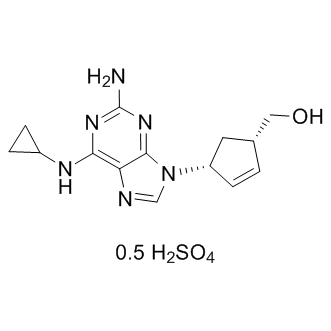
Abacavir sulfate
CAS No. 188062-50-2
Abacavir sulfate( Abacavir sulfate | Abacavir sulfate salt )
Catalog No. M12916 CAS No. 188062-50-2
A nucleoside reverse transcriptase inhibitor (NRTI) that used to prevent and treat HIV/AIDS.
Purity : >98% (HPLC)
 COA
COA
 Datasheet
Datasheet
 HNMR
HNMR
 HPLC
HPLC
 MSDS
MSDS
 Handing Instructions
Handing Instructions
| Size | Price / USD | Stock | Quantity |
| 10MG | 35 | In Stock |


|
| 25MG | 58 | In Stock |


|
| 50MG | 88 | In Stock |


|
| 100MG | 124 | In Stock |


|
| 200MG | 174 | In Stock |


|
| 500MG | Get Quote | In Stock |


|
| 1G | Get Quote | In Stock |


|
Biological Information
-
Product NameAbacavir sulfate
-
NoteResearch use only, not for human use.
-
Brief DescriptionA nucleoside reverse transcriptase inhibitor (NRTI) that used to prevent and treat HIV/AIDS.
-
DescriptionA nucleoside reverse transcriptase inhibitor (NRTI) that used to prevent and treat HIV/AIDS.HIV Infection Approved(In Vitro):Abacavir (15 and 150 μM, 0-120 h) sulfate inhibits cell growth, affects cell cycle progression, induces senescence and modulates LINE-1 mRNA expression in prostate cancer cell lines.Abacavir (15 and 150 μM, 18 h) sulfate significantly reduces cell migration and inhibits cell invasion.Abacavir sulfate induces fat apoptosis.(In Vivo):Abacavir (0-7.5 μg/mL, 100 μL, intrascrotal administration; 100 and 200 mg/kg, p.o.; 4 h) sulfate dose-dependently promoted thrombus formation.Abacavir (50 mg/kg/d; i.p.; 14 days) sulfate with 0.1 mg/kg/d Decitabine (HY-A0004) enhances survival of high-risk medulloblastoma-bearing mice.
-
In VitroAbacavir (15 and 150 μM, 0-120 h) sulfate inhibits cell growth, affects cell cycle progression, induces senescence and modulates LINE-1 mRNA expression in prostate cancer cell lines.Abacavir (15 and 150 μM, 18 h) sulfate significantly reduces cell migration and inhibits cell invasion.Abacavir sulfate induces fat apoptosis. Cell Proliferation Assay Cell Line:PC3, LNCaP and WI-38 Concentration:15 and 150 μMIncubation Time:0, 24, 48, 72 and 96 h Result:Showed a dose-dependent growth inhibition on PC3 and LNCaP.Cell Cycle Analysis Cell Line:PC3 and LNCaP Concentration:150 μM Incubation Time:0, 18, 24, 48, 72, 96 and 120 h Result:Caused a very high accumulation of cells in S phase in PC3 and LNCaP cells, and G2/M phase increment was observed in PC3 cells.Cell Migration Assay Cell Line:PC3 and LNCaP Concentration:15 and 150 μM Incubation Time:18 h Result:Significantly reduced cell migration.Cell Invasion Assay Cell Line:PC3 and LNCaP Concentration:15 and 150 μM Incubation Time:18 h Result:Significantly inhibited cell invision.
-
In VivoAbacavir (0-7.5 μg/mL, 100 μL, intrascrotal administration; 100 and 200 mg/kg, p.o.; 4 h) sulfate dose-dependently promoted thrombus formation.Abacavir (50 mg/kg/d; i.p.; 14 days) sulfate with 0.1 mg/kg/d Decitabine (HY-A0004) enhances survival of high-risk medulloblastoma-bearing mice. Animal Model:Male mice (9-weeks old, 22-30 g) - wild-type (WT) C57BL/6 or homozygous knockout (P2rx7 KO, B6.129P2-P2rx7tm1Gab/J) Dosage:2.5, 5 and 7.5 μg/mL, 100 μL or 100 and 200 mg/kg Administration:Intrascrotal or oral administration for 4 h Result:Dose-dependently promoted thrombus formation.Animal Model:NSGTM mice, patient-derived xenograft (PDX) cells of non-WNT/non-SHH, Group 3 and of SHH/ TP53-mutated medulloblastoma Dosage:50 mg/kg/d with 0.1 mg/kg/d Decitabine Administration:Intraperitoneal injection, daily for 14 days Result:Inhibited tumor growth and enhanced mouse survival.
-
SynonymsAbacavir sulfate | Abacavir sulfate salt
-
PathwayMicrobiology/Virology
-
TargetHIV
-
RecptorHIV-1reverse-transcriptase
-
Research AreaInfection
-
IndicationHIV Infection
Chemical Information
-
CAS Number188062-50-2
-
Formula Weight286.3323
-
Molecular FormulaC14H18N6O
-
Purity>98% (HPLC)
-
Solubility10 mM in H2O
-
SMILESC1CC1NC2=C3C(=NC(=N2)N)N(C=N3)C4CC(C=C4)CO.C1CC1NC2=C3C(=NC(=N2)N)N(C=N3)C4CC(C=C4)CO.OS(=O)(=O)O
-
Chemical Name2-Cyclopentene-1-methanol, 4-[2-amino-6-(cyclopropylamino)-9H-purin-9-yl]-, (1S,4R)-, sulfate (2:1)
Shipping & Storage Information
-
Storage(-20℃)
-
ShippingWith Ice Pack
-
Stability≥ 2 years
Reference
molnova catalog



related products
-
Dolutegravir
Dolutegravir (GSK1349572) is a potent, next-generation HIV integrase (IN) inhibitor, inhibits HIV-1 integrase-catalyzed strand transfer with IC50 of 2.7 nM.
-
HIV-1 Integrase Inhi...
HIV-1 Integrase Inhibitor 7 is an allosteric HIV-1 integrase inhibitor that inhibits the LEDGF/p75-integrase interaction.
-
gp120-α4β7 binding i...
gp120-α4β7 binding inhibitor 11 is an anti-HIV agent. gp120-α4β7 binding inhibitor 11 interferes the binding of HIV associated glycoprotein gp12G with the integrin α4β7 (IC50=1.64nM).



 Cart
Cart
 sales@molnova.com
sales@molnova.com


